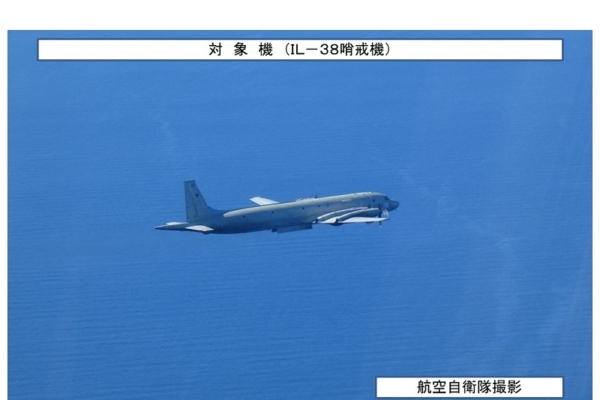On September 24, 2024, the Japanese government stated that a Russian military surveillance aircraft trespassed into Japanese airspace near the northern end of the main island of Hokkaido three times between 1 PM and 3 PM local time on Monday, September 23. This violation prompted the Japan Air Self-Defense Force to scramble F-35 and F-15 fighter jets and employ illumination flares for the first time to warn the invading Russian aircraft.
The Japanese government lodged a strong protest through diplomatic channels to Russia, urging them to prevent a recurrence of the incident near Rebun Island.
According to the Japanese Ministry of Defense, following two prior violations of airspace by the Russian aircraft, Japan issued warnings via radio. However, when the Russian aircraft intruded for the third time, Japanese jets were deployed to launch illumination flares.
Defense Minister Konoe Minori told reporters that the Russian IL-38 anti-submarine aircraft violated Japanese airspace near Rebun Island three times during a five-hour flight, with each intrusion lasting about a minute.
He noted that there have been multiple Chinese and Russian vessels navigating in the waters around Japan recently, indicating a potential connection to the airspace intrusions.
Minori stated, “The act of airspace violation is extremely regrettable.” He expressed Japan’s “strong protest” to Russia through diplomatic channels and called for preventive measures.
“We will closely monitor their military activities and carry out warning and surveillance operations,” Minori added.
Japanese Prime Minister Akita Fumio, currently visiting the United States, instructed the Japanese military to respond calmly and resolutely to the intrusion, emphasizing close cooperation with the United States and other relevant parties to provide timely and accurate information to the public and the international community. A liaison office has been established within the Prime Minister’s office for this purpose.
This incident marks the 44th violation of Japanese airspace by Russian aircraft and the first intrusion since October 2023, also representing the initial violation by Russian military aircraft since 2019.
In line with Japanese protocol, when foreign aircraft approach or enter Japanese airspace, the Self-Defense Forces first issue warnings via radio. If these warnings fail to prompt the foreign aircraft to leave, illumination flares are used for further warning.
In the event of an attack, the Self-Defense Forces aircraft will take defensive action, raising the possibility of escalation based on the actions of the Russian pilots. Photos released by the Self-Defense Forces show the bomb bay doors of the Russian anti-submarine aircraft were open.
Rebun Island is the location of a Japan Ground Self-Defense Force base, crucial for defense along Japan’s northern border despite the focus shifting to the southwestern part of Japan to address tensions in the Taiwan Strait and Chinese military buildup.
In recent times, Japan has encountered repeated intrusions by Chinese and Russian military aircraft and vessels. On August 26, a Chinese military aircraft violated Japanese airspace for the first time. Last Sunday and Monday, Chinese and Russian naval vessels passed through the Soya Strait near Rebun Island.
Yu Koizumi, Associate Professor at the Institute for Advanced Studies on Science and Technology at the University of Tokyo, suggested that the Russian aircraft incursions are likely linked to sailing with Chinese and Russian warships.
“It appears they are conducting anti-submarine exercises,” Koizumi stated.
Last week, the Chinese aircraft carrier Liaoning, escorted by two destroyers, sailed between the westernmost Japanese islands of Yonaguni and nearby Ishigaki, entering waters close to Japan.
According to Japanese military sources, from April 2023 to March 2024, Japanese aircraft were scrambled nearly 669 times on emergency missions, with about 70% directed at Chinese military aircraft, excluding instances of Chinese military aircraft violating Japanese airspace.
Earlier this month, there was an increase in military activities near Alaska involving China and Russia. As more Russian military aircraft and vessels approached various territories, the U.S. military deployed around 130 troops and mobile rocket launchers to a desolate island in the western Aleutian Islands of Alaska.
In recent days, with joint military exercises conducted by China and Russia, eight Russian military aircraft and four naval vessels (including two submarines) approached Alaska.
The North American Aerospace Defense Command reported that in July, two Russian Tu-95 and two Chinese H-6 bombers were intercepted by U.S. F-16 and F-35 fighters, Canadian CF-18s, and other support aircraft.

